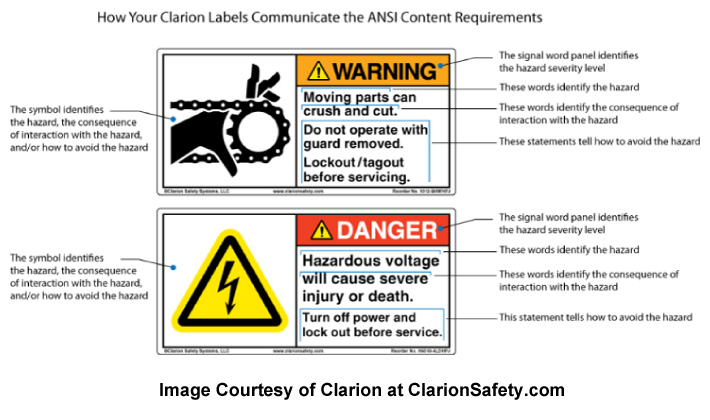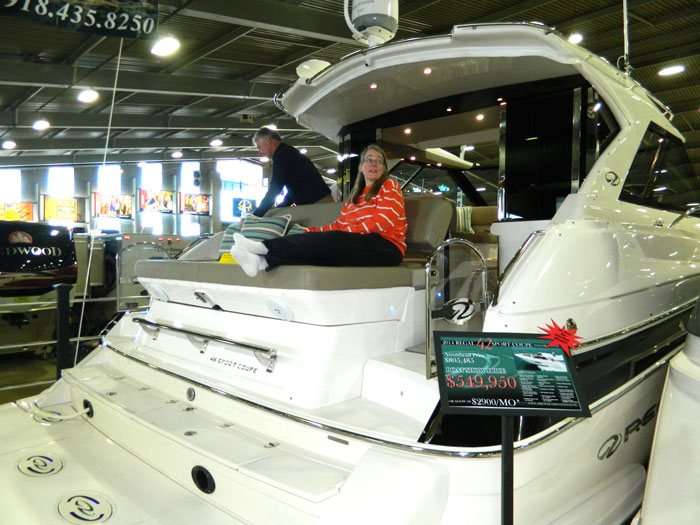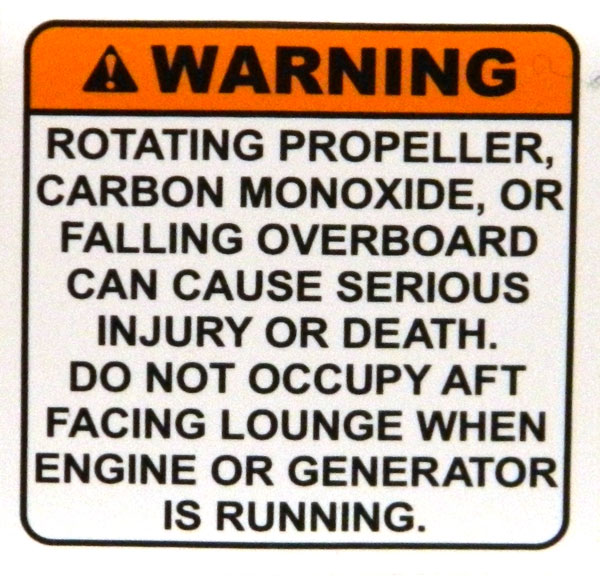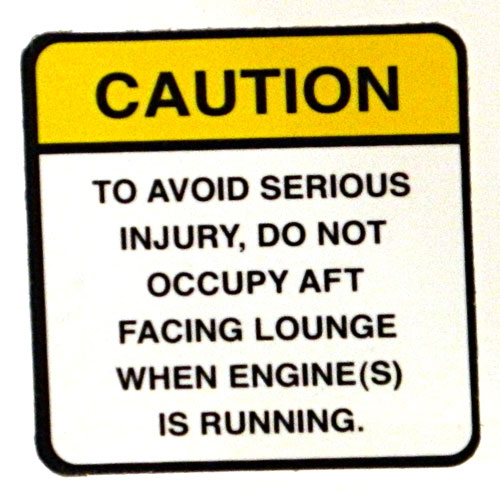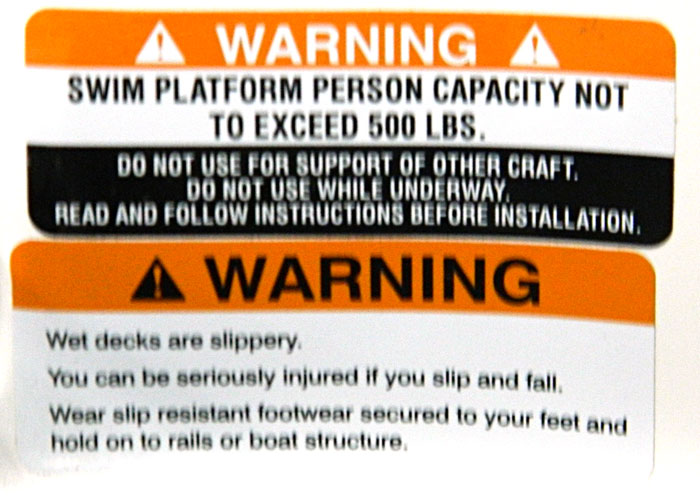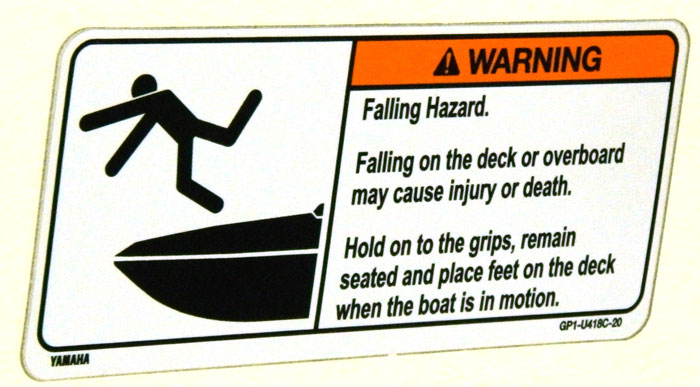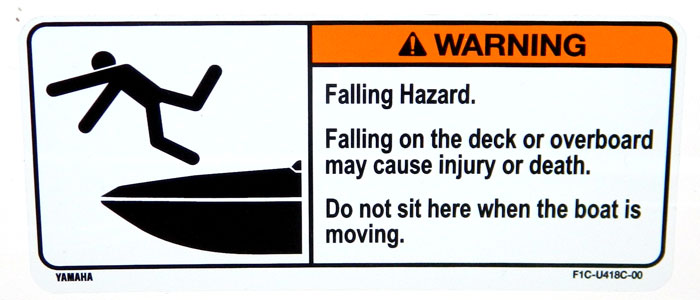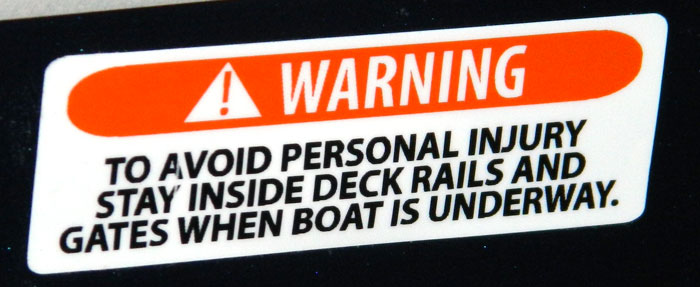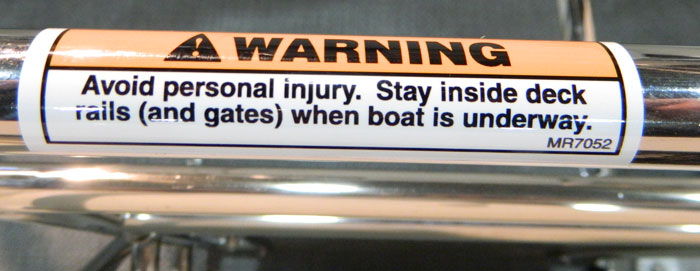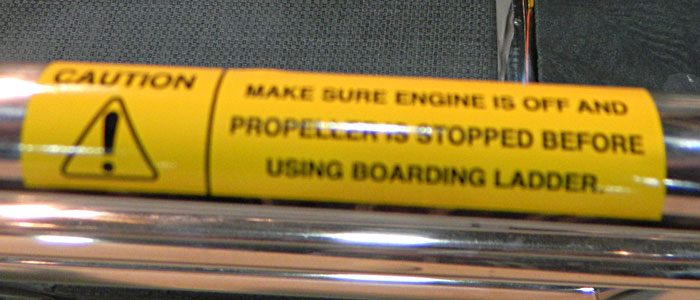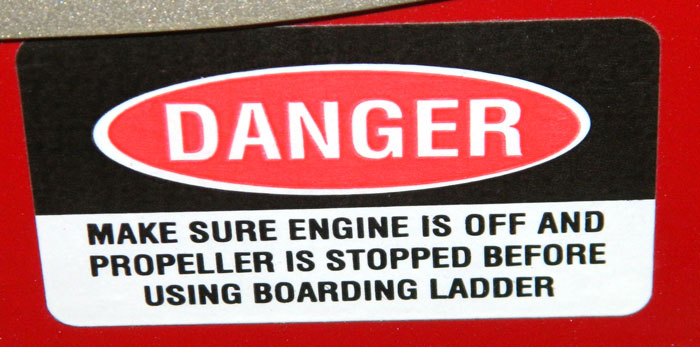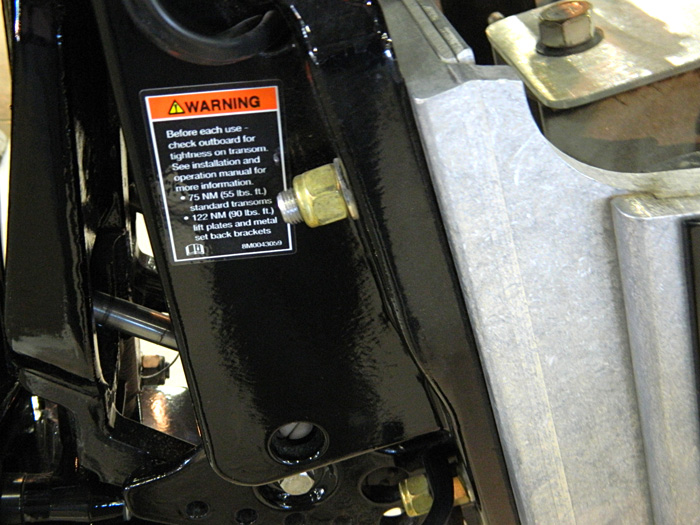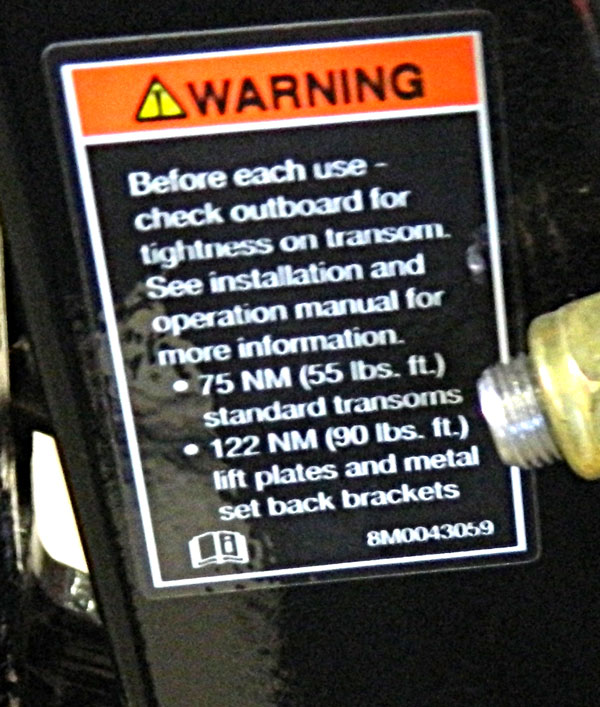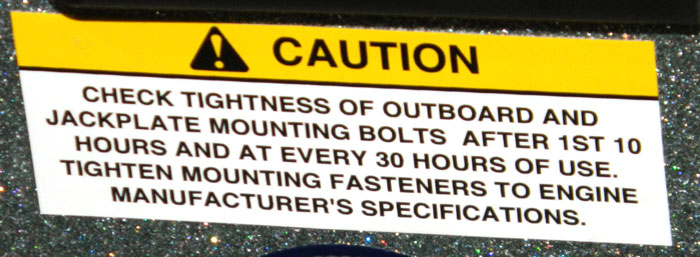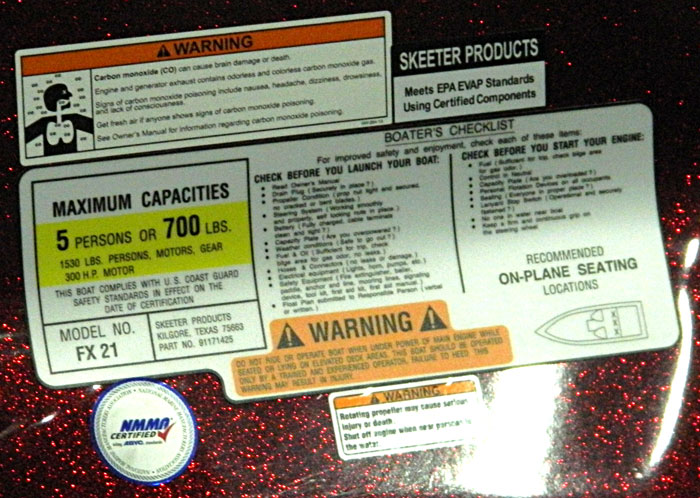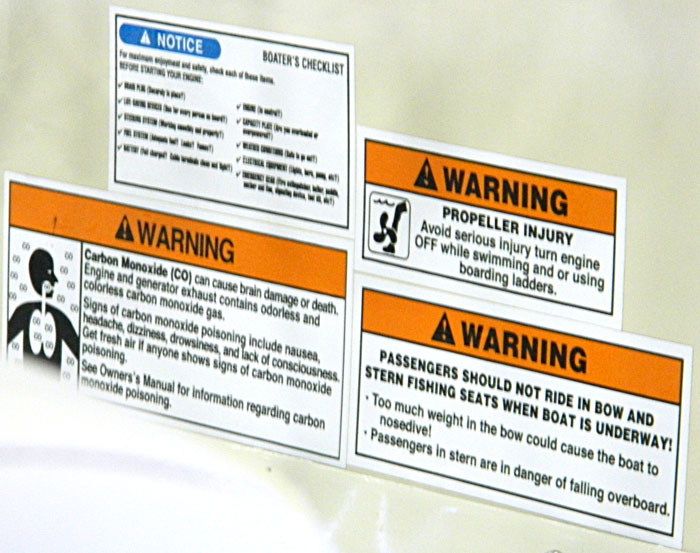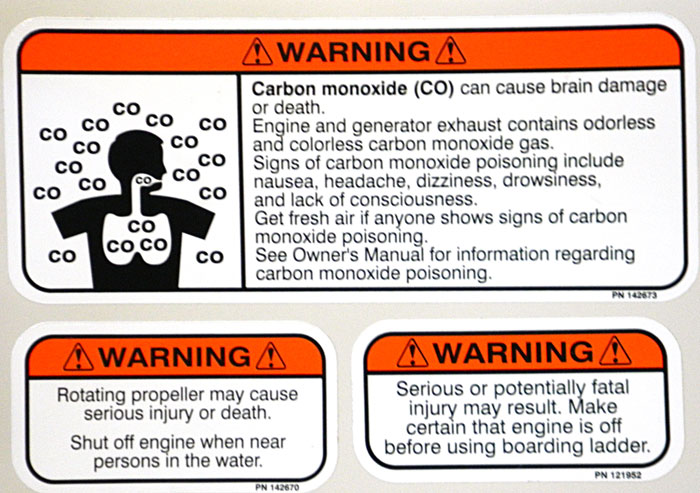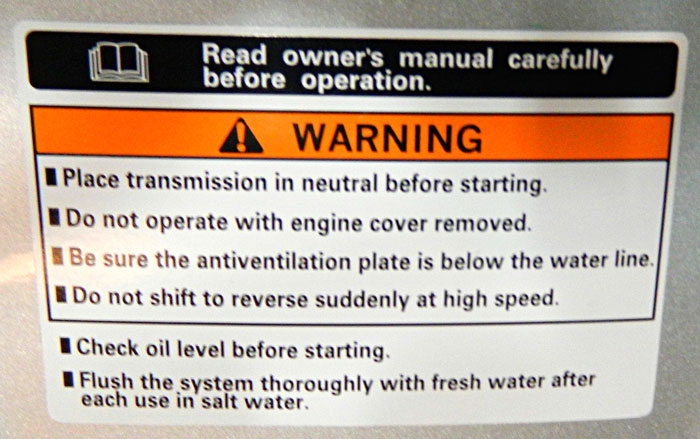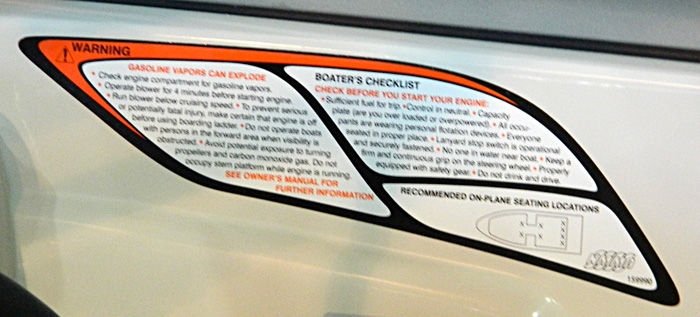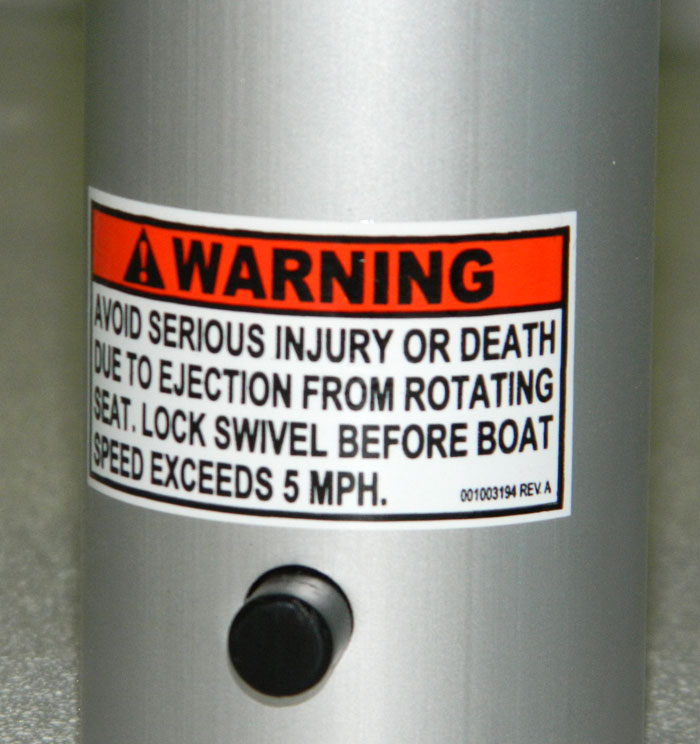Propeller Warning Labels seen at the 2014 Tulsa Boat Show: Part 1
We attended the 2014 Tulsa Boat Show on Wednesday afternoon January 29, 2014. This post is Part 1 of our two part coverage of propeller warning labels at 2014 show. It follows up on our 2012 and 2013 posts on Propeller Warning Labels at the Tulsa Boat Show. Lora and I walked around and photographed propeller warning labels / decals. Shortly after we started walking the show, I saw Phil Keeter, President of the Tulsa Boat Show. We had a nice visit about how big the show is this year and how much press it was getting.
The variety of decals and warnings continues to amaze us year after year. Once again, Lora noted we were seeing more decals that last year. But just like last year, some boats had no warnings at all at the stern.
Last year we spun off a separate post about the popularity of rearward facing seats at the swim platform and our concerns for the safety of those using them. This year they are everywhere. We acknowledge most have a warning label telling you not to ride in them when underway or when the engine is running, but suspect the warnings are often not followed.
Our discussion of warning labels is very timely right now as the American Boat and Yachting Council (ABYC) Standards Week met in January 2014. They met in part to discuss the future of ABYC’s T-5 Safety Signs and Warnings technical information report. Some feel ABYC should do away with the standard and just use ANSI Z535-4. Others want to update T-5 which was last updated in 2002. The draft minutes on the meeting are not very specific, but it sounds like they plan to update T-5 and make it a standard.
Lets just say that T-5 in its current condition is not a very demanding technical information report (that is being nice).
Although we also saw several propeller warning labels identical to the ones we saw at the 2012 and 2013 Tulsa Boat Shows, we did not repost them. The only ones we show below are those new to our sample of propeller safety related labels.
ANSI Z535.4 is the widely used standard commonly associated with 3 panel warnings such as those displayed below.
We continue to encourage the industry to follow ANSI Z535. The standards come from a committee that was originally formed in 1979, yet the boating industry still tries to hang onto ABYC’s T-5 technical information report.
Last year we posted a separate page of warnings on swim platform rear facing seats and the dangers they create for people who might not follow the warnings and ride in them while underway. This year we saw even more aft facing seats like the Regal 42 Sports Coupe above.
We just wanted to take a minute to thank the gentleman in this photo for his courtesy to us, for answering our questions, and for demonstrating the many features of Regal’s aft facing seat. At first we were a bit puzzled how one would get on it, sit on it, be able to put their feet on the lower rail, etc. He exhibited great patience and did a wonderful job of demonstrating this vessel and its rear facing seat. That is Lora enjoying relaxing on the aft seat. Good thing we didn’t bring our checkbook. If anybody is interested in a large luxury boat, we suggest you look him up at Arrowhead Boat Sales.
This warning tries to combine an aft facing seat warning with some other warnings (rotating propellers, carbon monoxide). It fails to put borders around the signal word panel or around the text panel. Text is in all caps and centered, making it pretty hard to read. Additionally the multiple warnings are not bullet pointed, they just all run together.
Similar to the warning below, it uses many short lines of text (nine in this instance), making it hard to grasp at a glace.
Another multi-warning addressing aft facing seating and other issues. This one covers rotating propellers, carbon monoxide, falling overboard, and aft facing seating. They tell you not to occupy aft facing lounge when the engine or generator are running, after they tell you being struck by a rotating propeller, carbon monoxide, and falling overboard can cause serious injury or death. The warning does not make a solid connection between the bad things and occupying the aft facing lounge when the engine or generator are running.
The text is in all caps and centered making it hard to read. NMMA’s separate carbon monoxide warning was right beside it, adding to the confusion.
While all the other aft facing seating warnings used the signal words Danger, or Warning. This boat builder (Formula) uses “Caution”. The signal word “Caution” is to be used if the worst credible severity or harm that could come to a person is Moderate or Minor Injury. We suggest that falling off aft facing seats and being struck by the boat’s propeller is much more severe than that.
The label is in all caps, centered, and the text lines are quite short in length, leading to the message requiring six lines. Being spread over so many lines makes it hard to remember and put together as you read line after line. The use of “engine(s) is running” creates a singular/plural issue that disrupts our reading of the warning.
In addition, the label is mounted under the seat at about ankle level (near the speakers). It would be very hard to read.
The combination of two separate warnings near the swim platform is interesting. I apologize for the poor focus. The top warning has no borders around the signal word or the text. The text is split into a white area (500 pound limit). The black area tells use not to put other craft there, not to use when underway, and to “read and follow the instructions before installation”.
We find a warning on the product after it has been installed that tells us to do something before we installed it, distracting. It no longer serves a purpose.
The second warning similarly has no borders and no pictograph. Its signal word and the safety alert symbol are in black, vs. the warning just above it has the signal word and safety alert symbol in white. The upper warning has two alert symbols, while the bottom warning has only one alert symbol. The upper warning is in all caps and centered. The lower warning is in mixed upper and lower case and left hand justified. Together, they are quite distracting and chaotic.
If “Warning” is the correct signal word, the warnings could all be grouped under one warning signal word.
The second warning talks about wet decks being slippery. Its presentation (order of the text) fails to follow ANSI Z535.4.
Above is a falling hazard warning from Yamaha. We noted it is slightly different from the one we saw last year.
The 2013 warning said not to sit here. This year (2014) they tell you to hang on.
We discuss these two different stay inside the deck rails warnings together.
The first one is a large flat warning, the second is rolled around a tube on the top of a pontoon boat gate making it harder to read, and probably exposing it to more wear as hands open and close the gate.
The first warning has no borders, no pictograph, is in all caps, and the text is centered. All characteristics that make it harder to read. In addition, the signal word box (warning) is rounded on the ends vs. the rectangular standard.
The second warning has borders, no pictograph, and is in mixed upper and lower case. The two lines of text are close to the same length, so at a very quick glance it looks to be left justified. After a closer inspection, we suspect the text is centered. At any rate, the second warning is much closer to ANSI Z535.4 than the warning above it. But, being stuck on the top edge of a pontoon boat gate tube makes it much harder to read.
Neither warning spells out the actual hazard (falling overboard, drowning, being struck by the propeller, etc.)
This pair of boarding ladder warnings also exhibit considerable differences. The top one is another pontoon boat warning stuck on the top of a tubing rail. The entire label is in yellow and the signal word is “Caution”. The signal word “Caution” means the most severe consequences of failing to follow the instructions provided would be moderate or minor injuries. Using the boarding ladder with the engine on and the propeller rotating presents an opportunity to be severely injured or killed. This warning obviously uses the wrong signal word. Being bent over the rail makes it hard to read. The text is in all caps and centered, also making it hard to read.
The second boarding ladder warning uses the old style elliptical white on red danger sign with no borders around the text, a black background up in the signal word area, all caps and centers the text. The warning bears no resemblance to modern ANSI Z535.4 warnings. We admit it grabs your attention which is important, but it fails to comply with modern standards.
Above are two photos of a Mercury Marine warning on an outboard motor instructing the proper torque for the bolts holding the outboard to the transom of lift plate (a jack plate in this instance).
Below the two photographs of the Mercury Marine warning is a similar warning applied to the transom of a boat (I think it is a Ranger bass boat). This warning uses “Caution” as the signal word, then instructs the fasteners be tightened to engine manufacturer specifications.
We include these warnings because they are on or near the transom, and because many outboard motors have broken loose and flipped into boats after striking submerged objects with their propellers still rotating. Keeping the mounting bolts and jackplate bolts tight helps prevent the outboard motor from slipping off. The outboard can still break off, but breaking off typically requires more force than slipping off.
Clusters of Warnings
The U.S. Coast Guard hired a contractor, Design Research Engineering (DRE), to assist in developing a few large warning labels that would each consist of an organized cluster of warnings commonly found on boats. DRE examined U.S. Coast Guard Boating Accident Report Database (BARD) data to get a feel for the frequency and severity of various types of accidents in order to prioritize the many possible warning messages. The intended result, is something of the nature of the large multiple warning and instructional label currently seen on Personal Watercraft (PWC). Boat builders would then add individual warning labels for any warnings specific to their boat not covered by the larger multi-warning labels.
Meanwhile we see some builders somewhat building their own large warning label by clustering several separate warning labels together, most often by the operator. A few examples are below.
The cluster above was observed on a Skeeter. It also includes a “Boaters Checklist” we observed in several different forms on other boats at the show.
This cluster includes another version of a boater’s checklist, a carbon monoxide warning, a propeller injury warning, and a warning to stay out of certain seats when underway.
We found the propeller warning particularly interesting. It includes a graphic of a propeller, human leg, and foot. The top text line is in all caps, the following lines are in mixed upper and lower case. The image has rounded borders and is not in its own separate panel.
If all three of the separate labels truly belong under the “Warning” signal word, they could have been bullet pointed under a single warning label bearing the “Warning” signal word. Or perhaps, the Carbon monoxide warning could have been left by itself, and the other two warnings could have been combined.
We do salute the manufacture for including a graphic on the swimming and boarding ladder Propeller Injury warning, but encourage them to convert it to the ANSI Z535.4 format (three panel warning, left justified text).
This cluster comes from a Sun Tracker (we think). They also combined three separate warning labels for carbon monoxide, rotating propellers, and the boarding ladder. All three warnings have rounded corners. The carbon monoxide warning has a lot of text with no white space between new paragraphs making it hard to read. The text is left hand justified.
The two propeller warnings center their text. All three warnings combine upper and lower case text making them easier to read.
The warning above was one of the more unusual warnings observed at the show. Printed on one label with a white background, the top edge is a white text on black background telling you to read the owners manual. The black strip is followed by a more traditional looking warning (orange panel with signal word “Warning” and the alert symbol). The text of the warning is four bullet points (used squares for round bullets) providing four separate instructions (shift to neutral before start, make sure the engine cover is on before operating, make sure the antiventilation plate is below the water line, and don’t shift into reverse at high speed).
No consequences of any of those actions (or inactions) are presented and no pictorials are provided. A border surrounds the four instructions, creating a familiar text panel.
Below the text panel are two more bullet points using the same square bullets. They tell you to check the oil before starting, and to flush the system after use in salt water.
The entire combination of three groups of thoughts (read owners manual, four bullet points under the warning signal word, and two more bullet points with no heading), leaves us pretty confused.
NMMA has put together the start of combined boating checklist with some instructions/warnings about gas vapors and some on plane seating instructions. Again, we think this was on a Sun Tracker.
The signal word “Warning” is so far to the top and left that many may not see it. The unusual shape outlining the three white panels resembles a pair of glasses. The alert symbol is partially below the signal word, “Warning”.
Bullet points in the gas vapors section run together (each one does not begin on a separate line). While the heading is “Gasoline Vapors Can Explode”, several of the bullet points have to do with boat propeller safety.
We find it unusual that NMMA continues to create warnings so far removed from ANSI Z535.4 standards.
The above warning was on a pedestal seat. We included it because several people have fallen overboard from pedestal seats, and some pedestal seats have broken loose while underway, sending their occupants into the water, placing them at risk to propeller strikes.
